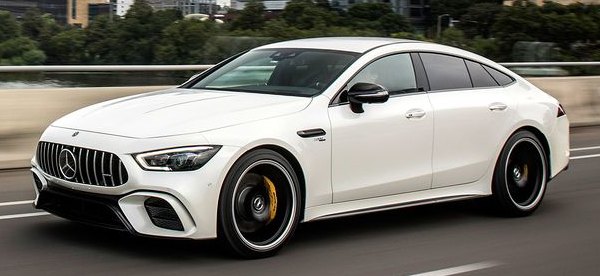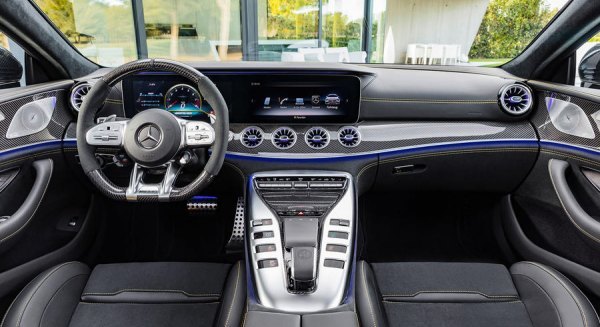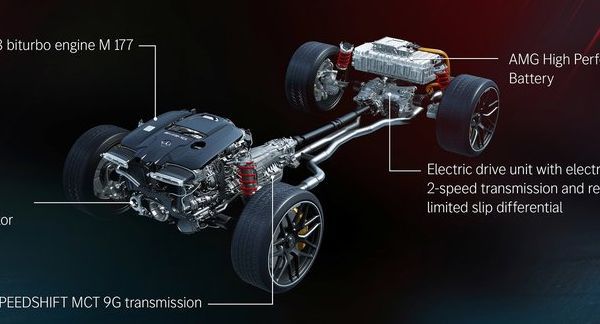Published
on 28
Nov 2018
|
All rights reserved.
|
|

|
|
A
revamped CLS? The AMG GT 4-Door is far more than that.
|
|
Although the AMG nameplate
has been existing for half a decade, it became part of the Mercedes
organization only since 1999. 10 years later, it built its first
dedicated model, SLS. 4 years ago arrived the second model, AMG GT.
Both SLS and GT managed to establish a good reputation for the
performance brand, good enough to be seen as an equal of Porsche.
However, when it comes to profit, they contribute little, or none. AMG
still earns its living by modifying Mercedes’ production saloons,
wagons and hatchbacks. Is there room for a more mainstream AMG
exclusive model? AMG believes yes, and we have no reason to doubt.
Considering Porsche can convert a VW Toureg into Cayenne and Audi Q5
into Macan, there should be plenty of rich customers wanting to buy
something more useable than sports cars yet preserving the performance
image of AMG. So, here comes the AMG GT 4-Door.
Make no mistake, the AMG GT 4-Door is by no means the stretched and
4-door version of the AMG GT. Far from it actually. While the GT sports
car is constructed out of a dedicated front-mid-engined layout and an
aluminum spaceframe chassis, the 4-Door is built upon the MRA platform
of any large Mercedes sedans, the closest of which is CLS. It shares a
similar, 4-door coupe body profile and essential mechanicals. Now you
may question: doesn’t it clash with the CLS in market positioning?
Somewhat yes, but Mercedes limits the damage by reassigning the CLS a
lower position, while the AMG GT 4-Door sits above it. That is why the
new CLS has lost the range-topping ’63 model and a large part of its
attraction. Over time, I’m afraid the CLS will become the casualty of
AMG GT 4-Door. Its future is bleak.

|
|
It
is weighty, but the chassis is stiffer than that of the CLS.
|
|
The 4-Door employs a steel-aluminum hybrid monocoque similar
to that of the CLS, but it is strengthened by an aluminum plate under
the engine and 3 braces across the transmission tunnel. Like its
sibling, the bonnet and front fenders are aluminum sheets. The rear
bulkhead and boot floor are converted to lightweight carbon-fiber
reinforced plastics, but still, the car is heavier than the CLS. A
six-cylinder mild-hybrid CLS53 weighs 1905kg. The equivalent GT 4-Door
is 65kg heavier
still, pushing it to the edge of 2 tons. Meanwhile, the flagship ’63 S
model tips the scale at 2045 kg. If Ferrari or Aston Martin build such
a car, I think they could be 200kg lighter yet have a better weight
distribution. That said, the AMG is comparable to a Porsche Panamera in
terms of weight – if not rear seat accommodation, since the Porsche
does not have such a swoopy roof line.
Fortunately, AMG knows how to style the car to appeal. The 4-Door looks
handsome, fast and special. It employs AMG’s trademark “Panamericana”
grille, which looks fire-breathing. Its fastback form is different from
the 4-door shape of the CLS, while its tailgate gives easier access to
the load bay. Interestingly, the combination of its round tail,
fastback and shallow side windows gives an impression of a modern,
4-door version of Porsche 928. Porsche should have given the Panamera a
shape like this, shouldn’t it?
As for aerodynamics, the car employs active air panel up front and a
multi-stage retractable and extended rear spoiler. For even more
downforce, you may opt for a fixed (but manually adjustable) rear
spoiler.

|
|
Porsche
should have given the Panamera a shape like this, shouldn’t it?
|
|
The car offers 4 models: both the entry-level GT43 and GT53 employ
Mercedes’ new 3-liter straight-6 with one turbo, one electric charger
and EQ-boost mild hybrid assistance, which offers a short boost of up
to 22hp and
184lbft. The petrol engine produces 367hp on GT43 or 435hp on GT53,
equaling to those of CLS450 and CLS53. Meanwhile, both GT63 and GT63 S
employ the familiar 4-liter V8 with a pair of twin-scroll turbos and
cylinder deactivation. They produce 585hp/590lbft and 639hp/664lbft,
respectively – the latter surpasses E63 S by 27hp and 37lbft, thanks to
remapped ECU and the use of ball-bearing turbos. The 6-cylinder motor
partners with conventional 9G-Tronic automatic, while V8s pair with
AMG’s own 9-speed MCT multiplate clutch transmission. Their top speeds
are 168, 177, 193 and 196mph, respectively. 0-60mph takes 4.7, 4.3, 3.3
or 3.1 seconds. This means, the GT63 S is the fastest accelerating ever
AMG model, more so than E63 S and AMG GT R !
The suspensions and steering are essentially the same as those of CLS,
but the calibration is sportier, of course. All models employ the
rear-biased 4matic+ system with rear-drive Drift mode as you can find
on E63 S. The 6-cylinder models use steel spring suspension with
adaptive dampers, whereas V8s employ air suspension. 4-wheel steering,
first used on the AMG GT R, is standard on the V8s, but only the
flagship GT63 S gets active rear differential and adaptive engine
mounts. In terms of performance equipment, the AMG 4-Door offers
everything you can dream of.

|
|
The
only visual link to the GT sport car is the flashy, prominent
transmission tunnel.
|
|
The Mercedes interior is rich and elegant, of course, but it is largely
the same as that of the CLS or E-class. The only noticeable difference
is the flashy, prominent transmission tunnel, which provides the only
visual link to the AMG GT. The rear cabin can be either a bench seat
for 3 or 2 individual seats. Legroom is good. Headroom is less so, but
enough for six-footers.
In normal driving with the suspension setting in Comfort mode, the GT
4-Door is a rather civilized machine. It rides nicely, if not as good
as the CLS on harsher surfaces. It cruises smoothly and quietly at
speed. Even in Sport mode, the suspension is firm but not
uncomfortable.
However, the chief mission of this car is to entertain, and it is glad
to do so. The GT53 might not be as hot as the V8 model, but it offers
sufficient power to entertain. The straight-six motor is smooth, its
power delivery is linear and the 48V electric motor provides the
necessary boost at the low end. Moreover, its exhaust note is musical,
something getting rarer and rarer these days. However, the GT63 S lands
on a different level. Its ability to accelerate is incredible, not far
from the level of supercars. Its V8 is a gem, trailing only Ferrari’s
V8 for minimum lag and quick throttle response, producing a
deep-chested roar at rev and crazy crackles on overrun. Yet with
4-wheel drive and the responsive MCT gearbox, the V8 lays down its
power efficiently to the road, converting to kinetic energy without
fuss. The titanic mid-range torque, 664 pound-foot, is eye-opening,
easily masking the weight of the car. Unquestionably, this is the
world’s fastest 4-door 4-seater.

|
|
This
is the world’s fastest 4-door 4-seater, also one of the most
entertaining to drive.
|
|
However, what makes the AMG GT 4-Door a dedicated AMG model
rather than a modified Mercedes is handling. Traditional AMG cars were
more about straight line speed than cornering. Although the recent E63
S with rear-biased 4matic+ system has changed that impression, it is
still not as good to handle as, say, a BMW M5. What the AMG GT 4-Door
excels over its sibling is the way its various systems are integrated
and calibrated – the 4matic+, the active diff, rear-wheel steering, air
suspension and stability control. They are more in a piece to deliver
more grip, more poise, flatter body control, keener turn-in… in short,
it feels more agile and more controllable. The addition of 4WS really
helps it to turn in tighter corners. The steering and brake pedal
provide great feedback, something you can’t say on the E63 S. The steel
brakes are powerful, good enough to withstand a few laps of track
abuse. As a result, you can trust on the car and all its controls. In
corner, the car displays a neutral balance, with just a hint of
stabilizing understeer. Stability control might be working behind the
scene, but it is undetectable. When the car approaches the limit, it
slides progressively and predictably, which is another improvement from
the all-or-nothing E63 S. Rear-wheel steering certainly helps it. The
power slide here is easier to catch and to extend than an M5 or
Panamera as well. AMG has done a great job to make the 4-Door a
world-class entertainer. You might find more agility and thrills from a
smaller car like Alfa Romeo Giulia QF, but for something as big and
luxury, the AMG is unbeatable.
The only question is pricing. The GT63 S costs £135,000 before
options. Even the GT53 demands £90,000, which can buy you an M5
Competition. Then again, the AMG GT 4-Door is a niche product, more
special to look and to drive. And certainly the people on street won’t
confuse it with a regular E-class or CLS.
|
Verdict:      |
Published on 14
Nov 2022
|
All rights reserved.
|
|
GT63 S E Performance
|

|
|
Plug-in
hybrid makes AMG GT 4-door astonishingly quick.
|
|
Mercedes-AMG GT63 S E
Performance, what a long name! Previously, this car was widely tipped
to be called "GT73e", which sounds fantastic to me. However, AMG wants
to promote the new “E Performance” label, which will be used to badge
all its electrified models in the future, so the flagship GT 4-door has
to be compromised. Although not using a higher number, the E
Performance
version of GT63 S sits at a higher performance level than its
conventionally powered sibling. It commands an eye-popping
£174,000, £30K clear of its lesser sibling as well as the
top Porsche Taycan Turbo S, Panamera Turbo S E-Hybrid and BMW M5 CS. In
the performance 4-door world, this is as expensive as you can get.
The new flagship sprints from rest to 62 mph in 2.9 seconds, 0.3s less
than the former range-topper. Moreover, AMG claims 0-124 mph in less
than 10 seconds, which is as quick as a Porsche Taycan Turbo S. Top
speed, however, remains unchanged at 196 mph, implying its electric
power cannot sustain high-speed run.
The E Performance model keeps the 4-liter twin-turbo V8 intact, still
producing 639 hp and 664 lbft of torque, driving through a 9-speed MCT
gearbox and 4matic+ system to all four wheels. What's new is the rear
axle. A new EDU (electric drive unit) combines the function of 3 – an
electric motor, a 2-speed gearbox and electronic LSD – in a compact
package. The electric motor can produce up to 204 hp and 236 lbft of
torque. Thanks to coupling it to a 2-speed gearbox, which switches to
2nd gear when the motor revs to its limit of 13,500 rpm at around 87
mph, the power delivery can match that of the V8. This means total
power is simply the summation of the two, i.e. 843 hp. Combined torque,
however, is even higher than the sum of two, at 1033 lbft (1400 Nm),
thanks to different gearing.

|
|
Rear-mounted
battery and EDU improve balance but add 260 kg and raise CoG.
|
|
Meanwhile, a lithium battery is mounted above the rear axle, which
improves front-to-rear balance from 54:46 to a perfect 50:50., if not
center of gravity. AMG said the inhouse-built battery has very high
power density, which can supply 95 hp continuously or 204 hp for
10 seconds. Anyway, it still weighs some 89 kg. In addition to the EDU,
the whole car weighs 2305 kg, or 260 kg more than the GT63 S. The
electric power normally drives the rear axle directly. Only when
special circumstances require the 4matic+ system will let the electric
power flows forward through mechanical connection.
The E Performance, as suggested by its name, is performance rather than
environmental-oriented. Its battery might have a high power density,
but not energy density. Its capacity is only 6.1 kWh, giving a
zero-emission range of merely 12 km or 7 miles. You may charge it at
home, but I doubt who would do so for a range not sufficient to take
you to a supermarket nearby and return. However, it is sufficient to
deceive WLTP test cycles, reducing emission from 293 to 196 g/km.
The rest of the car undergoes very few changes. There might be minimal
retuning to the adaptive air suspension to compensate for the extra
weight, and the standard fitment of ceramic brakes, but otherwise the
hardware is just the same.
 |
|
Outright
dynamics is not quite as strong as its ICE sibling, but you need to
drive on a track to realize.
|
|
On the road, the hybrid model is not a huge difference, but
acceleration from the low end is noticeably stronger. It picks up speed
as if a supercar, hugely admirable for a car so big and heavy.
Meanwhile, the aural excitement of the AMG V8 is kept intact. The car
also handles its mass in corner extremely well. Traction and grip are
huge, body control is tight, stability is high, and steering is
accurate.
However, on a track, push the car to the extreme for extended time, and
the laws of physics are finally exposed. You start feeling the extra
mass in earlier understeer and tires overheating, so that you need to
back off earlier before corner. The ceramic brakes remain strong under
repeated hard use, but the regenerative braking compromises its pedal
feel. In fact, AMG’s technical boss admits that the pure combustion
GT63 S has stronger outright dynamics. This might explain why AMG does
not reveal its Nurburgring lap time. Perhaps it is also why the firm
opts not to name it GT73e.
|
Verdict:     |
|